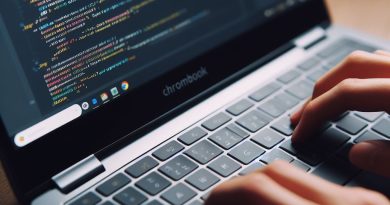Why Scratch is the Perfect Intro to the World of Coding
Last Updated on September 25, 2023
Introduction
In today’s world, coding has become an essential skill that opens up numerous opportunities.
With technology advancing rapidly, the ability to code allows individuals to create, innovate, and problem-solve effectively.
One of the best ways to introduce coding to beginners is through Scratch, a visual programming language.
Developed by MIT, Scratch provides a user-friendly platform for users to create interactive stories, games, and animations.
Its drag-and-drop interface makes it easy for beginners to understand and experiment with coding concepts.
Scratch enables users to learn key coding principles such as sequencing, loops, and conditionals while having fun.
It encourages creative thinking, logical reasoning, and collaborative skills, which are essential in today’s digital age.
Moreover, Scratch fosters a supportive community where users can share and remix each other’s projects, enhancing learning and collaboration.
By using Scratch as an introduction to coding, beginners can grasp the fundamentals of coding in an engaging and interactive way.
They can build a strong foundation that can be further expanded upon when learning more advanced programming languages.
Scratch provides the perfect stepping stone for beginners to enter the world of coding and unlock their creative potential.
What is Scratch?
Definition of Scratch
Scratch is a visual programming language that allows both kids and adults to create interactive stories, games, and animations.
It was developed by the Lifelong Kindergarten Group at the MIT Media Lab and released in 2007.
With its user-friendly interface and drag-and-drop programming blocks, Scratch makes coding accessible and enjoyable for beginners.
It aims to teach fundamental coding concepts while promoting creativity and problem-solving skills.
Explanation of its features
Here are some key features of Scratch that make it the perfect introduction to the world of coding:
- Visual Programming: Scratch uses colorful blocks that represent different commands and functions, making it easy to understand and visualize the code.
- Code Blocks: Users can create programs by snapping together code blocks, eliminating the need to type complex syntax or worry about typos.
- Abstraction: Scratch allows users to focus on the logic and structure of coding without getting overwhelmed by syntax details, fostering computational thinking.
- Event-Driven Programming: Users can create interactive projects by assigning actions to specific events or triggers, such as keyboard input or mouse clicks.
- Media Integration: Scratch supports importing and manipulating various media assets like images, sounds, and videos, enhancing the possibilities of project creation.
- Online Community: Scratch has a vast online community where users can share their projects, get feedback, and collaborate with others, making learning social and interactive.
One of the remarkable things about Scratch is its simple yet powerful interface.
The main workspace consists of a stage and a set of palette categories that contain different coding blocks.
Users can drag and arrange these blocks to create their scripts, which control the behavior of sprites, or characters, on the stage.
Examples of what can be done with Scratch
Now, let’s explore a few examples of what can be done with Scratch:
- Create a simple game where a character jumps over obstacles by using keyboard controls.
- Design an interactive story where users make choices that affect the plot and outcome.
- Develop a mini-animation that showcases a character moving and dancing to a catchy tune.
- Simulate a virtual pet that responds to user actions like feeding, playing, and sleeping.
- Build a quiz game that tests users’ knowledge by displaying multiple-choice questions.
These examples demonstrate the versatility and creativity that Scratch enables.
Users can bring their ideas to life by combining code blocks and multimedia elements, providing endless opportunities for exploration and learning.
Scratch serves as a stepping stone to more advanced programming languages by introducing core concepts such as loops, conditionals, and variables.
It helps develop logical thinking, problem-solving, and perseverance—all essential skills in today’s digital world.
Whether you’re a child curious about technology or an adult looking to dip your toes into coding, Scratch offers a welcoming and intuitive platform to ignite your passion for programming.
So why not give it a try and unleash your creativity with Scratch?
Read: Full-time vs. Part-time Dev: Comparing Coding Hours
Advantages of Scratch for beginners
Scratch is the perfect introduction to the world of coding for beginners for several reasons:
- Easy to learn and understand: Scratch is designed with a user-friendly interface that makes it accessible to beginners.
- Visual-based programming language: Scratch uses colorful blocks and graphical elements to represent code, making it easier to grasp programming concepts.
- Drag-and-drop system for coding: With Scratch, beginners can simply drag and drop blocks of code to build their programs, eliminating the need to memorize syntax.
- Immediate feedback and gratification: Scratch provides instant feedback, allowing beginners to see the results of their coding efforts immediately.
- Promotes creativity and problem-solving skills: Scratch encourages users to think creatively and develop problem-solving skills through building interactive projects.
Read: Project-Based Learning: Coding Websites That Offer Practical Skills
Building a solid foundation in coding
Understanding Key Concepts through Scratch
- Logic and Sequencing: Scratch teaches the fundamentals of logical thinking and the importance of sequencing in coding.
- Variables and Loops: Learners explore the essential concepts of variables and loops, building a solid foundation.
- Conditional Statements: It introduces learners to conditional logic, a fundamental coding concept.
- Event-Driven Programming: Scratch immerses users in event-driven programming, a crucial skill for interactive software development.
Through Scratch, beginners grasp these key concepts with hands-on, interactive experiences, setting a strong coding foundation.
Logic and Sequencing in Scratch
- Logical Thinking: Scratch fosters logical thinking, a fundamental skill in coding and problem-solving.
- Sequencing Mastery: Learners grasp the importance of sequencing, a cornerstone of programming.
- Visual Representation: Scratch’s visual blocks make it easy for beginners to understand and practice sequencing.
- Immediate Feedback: Instant results in Scratch empower learners to experiment and refine their logical sequences.
- Creativity Boost: Logic and sequencing, coupled with Scratch’s creative potential, make learning coding enjoyable and effective.
By mastering logic and sequencing in Scratch, beginners lay a solid foundation for their coding journey.
Variables and Loops in Scratch
- Fundamental Concepts: Scratch introduces beginners to the crucial concepts of variables and loops.
- Variable Exploration: Learners can create, manipulate, and understand variables, building problem-solving skills.
- Looping Simplicity: Scratch simplifies the understanding and application of loops, a key coding element.
- Hands-On Practice: Immediate feedback in Scratch allows learners to experiment and perfect their variable and loop skills.
- Problem-Solving: Variables and loops empower learners to tackle complex problems methodically and creatively.
By mastering variables and loops in Scratch, beginners gain essential coding skills, setting the stage for further exploration.
Conditional Statements in Scratch
- Introduction to Logic: Scratch eases learners into the world of logical thinking through conditional statements.
- If-Then Logic: Learners grasp the concept of “if-then” conditions, a fundamental coding element.
- Interactive Learning: Scratch’s visual interface allows hands-on practice with immediate feedback for conditional statements.
- Problem-Solving Skills: Understanding conditionals enables learners to solve real-world problems through coding.
- Creativity and Control: Conditional statements in Scratch empower learners to create interactive and dynamic projects.
By mastering conditional statements, beginners gain valuable coding skills that open doors to limitless creative possibilities.
Read: Pros and Cons: Coding Websites vs Traditional Textbooks

Introduction to the world of coding
Learning how to code can be a daunting task, especially for beginners.
However, Scratch provides the perfect introduction to the world of coding. It is a visual programming language that makes it easy for anyone to get started with coding.
Familiarity with real programming concepts
- Scratch allows users to learn and understand fundamental programming concepts.
- It teaches the logic behind coding through its block-based interface.
- Users can create projects by connecting various blocks together, which simulates the actual coding process.
- By using Scratch, beginners can become familiar with concepts like loops, conditionals, and variables.
Easy transition to other programming languages
- Once users have grasped the concepts in Scratch, transitioning to other programming languages becomes easier.
- The logical thinking skills acquired through Scratch are transferrable to other coding languages.
- Understanding the fundamental concepts of coding reduces the learning curve when transitioning to text-based languages like Python or JavaScript.
- Scratch’s visual nature helps bridge the gap between visual and text-based programming.
Exploring more advanced coding options
- While Scratch is a great starting point, it also offers advanced coding options.
- Users can create complex projects by utilizing advanced features like variables, procedures, and custom blocks.
- Scratch allows users to create interactive stories, games, and animations, enabling them to be more creative.
- As users gain confidence, they can explore more advanced coding techniques within the Scratch environment.
Inspiring interest in further coding education
- One of the main advantages of Scratch is its ability to inspire interest in coding.
- Its user-friendly interface and engaging community encourage users to continue their coding journey.
- Scratch fosters a sense of curiosity and creativity by providing endless possibilities for projects.
- By experiencing the joy of coding firsthand, beginners are more likely to pursue further coding education.
Scratch is the perfect introductory tool for those interested in learning how to code.
It not only familiarizes users with real programming concepts but also eases the transition to other programming languages.
Scratch offers advanced coding options and inspires interest in pursuing further coding education.
So, if you’re looking to enter the world of coding, Scratch is where you should start.
Read: Semantic HTML: Why It’s Important for Web Accessibility
Use Cases and Success Stories of Scratch Users
- Teachers globally have incorporated Scratch into their classrooms, encouraging creativity and critical thinking.
- Children and teenagers can create interactive stories, games, and animations, boosting their digital literacy.
- Startups have utilized Scratch as a prototyping tool to rapidly develop and test minimum viable products.
Showcasing Successful Projects Created with Scratch
Scratch has enabled countless individuals to turn their ideas into reality, producing impressive projects that showcase their coding skills. Some notable examples include:
- The “Super Mario Bros. Remake” created entirely in Scratch, demonstrating the platform’s versatility.
- A student-designed interactive educational game that teaches geography in a fun and engaging way.
- A collaborative animation project where users from different countries work together on a shared storyline.
Famous Individuals Who Started with Scratch
Scratch has served as a launchpad for many notable individuals who went on to achieve great success in the tech industry. Some famous personalities who started their coding journey with Scratch include:
- Mitch Resnick, the creator of Scratch, who developed this tool to inspire young learners.
- Natalie Rusk, a prominent computer science educator who has championed the use of Scratch in schools.
- Chris Bosh, the former NBA player, used Scratch to foster his interest in programming and later became an advocate.
The Thriving Scratch Community and its Support
One of the key factors contributing to Scratch’s success is its passionate and supportive community. With millions of users worldwide, Scratch offers:
- An online community where users can share their projects, receive feedback, and collaborate on new ideas.
- Regular Scratch Day events where enthusiasts gather to learn, showcase their work, and inspire others.
- Strong support from Scratch’s development team, who actively engage with users, address issues, and provide updates.
Scratch’s incredible popularity and impact can be attributed to its user-friendly interface, the creative freedom it offers, and the supportive community that surrounds it.
Aspiring coders of all ages can dive into the world of programming with confidence, knowing that they have all the necessary tools and resources at their disposal.
So why wait? Join the Scratch community today and embark on an exciting coding journey!
Conclusion
Scratch is the perfect introduction to the world of coding due to its numerous benefits.
It is a visual programming language that makes coding accessible and enjoyable for beginners of all ages.
Recapping the benefits of Scratch, it provides a user-friendly interface, allows for creativity and problem-solving, fosters collaboration, and builds a solid foundation for future coding languages.
For beginners who are hesitant to start coding, Scratch is the ideal platform to begin with.
Its simplicity, interactivity, and abundant online resources make learning coding a fun and rewarding experience.
As the world becomes increasingly digital, learning coding has become an essential skill.
Scratch not only teaches coding concepts but also encourages computational thinking, logical reasoning, and the ability to break down complex problems.
Whether you are a child, a teenager, or an adult, Scratch provides an inviting and engaging platform to explore the world of coding.
It ignites curiosity, unleashes creativity, and empowers individuals to become active participants in the digital era.
If you are considering venturing into the world of coding, don’t hesitate to try Scratch.
It is the perfect starting point that will not only introduce you to the fundamentals of coding but also inspire you to dive deeper into the vast world of technology.
So, what are you waiting for? Start coding with Scratch and unlock your potential to create and innovate!


